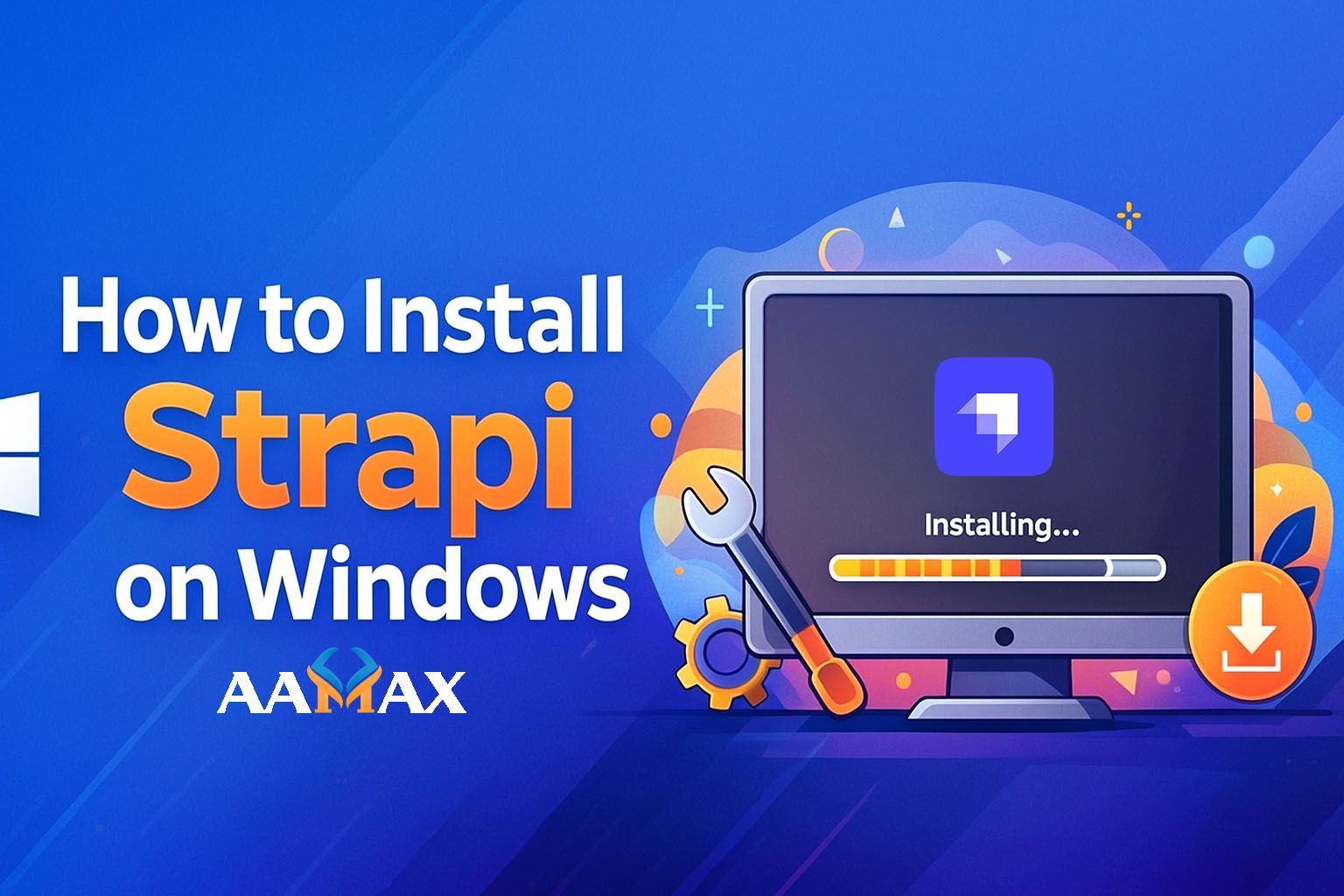
How to Install Strapi on Windows
Installing Strapi on Windows is a straightforward process once you understand the tools, configurations, and environment setup required for a smooth installation. Strapi is one of the most powerful open‑source headless CMS platforms, popular for its flexibility, customizability, and compatibility with modern technologies such as React, Next.js, Vue, Nuxt, and mobile frameworks like Flutter or React Native. When working in the Windows environment, developers often face challenges related to Node.js versions, permissions, or database configurations. This detailed guide will walk you through every step of installing Strapi on Windows in a clean, efficient, and production‑ready way.
Whether you're a beginner exploring best headless CMS tools or an experienced MERN developer wanting to integrate Strapi into your workflow, this tutorial covers everything you need. For businesses looking to build powerful, scalable digital platforms, you can also hire AAMAX --- a full‑service agency offering MERN Stack Development, Web Development, SEO, and Digital Marketing services.
What You Need Before Installing Strapi
Before beginning the installation, make sure your Windows system meets the following requirements.
Minimum Requirements
- Windows 10 or Windows 11 (64‑bit recommended)
- Node.js 18.x or higher (LTS recommended)
- NPM or Yarn package manager
- Visual Studio Code or your preferred editor
- Git (optional but recommended)
- Internet connection
Why These Requirements Matter
Strapi is built on Node.js, so ensuring you have the correct version installed avoids compatibility problems. Many developers mistakenly use outdated versions, causing installation failures. Windows also requires proper environment path variables to ensure Node.js commands run globally.
After confirming system readiness, let's move on to the installation steps.
Step 1: Install Node.js on Windows
Strapi runs on Node.js, so installing the correct version is critical.
Download Node.js
- Visit the official Node.js website.
- Choose the LTS (Long‑Term Support) version.
- Download and run the installer (.msi file).
Install Node.js
During the installation: - Accept the license agreement. - Choose the installation path. - Ensure "Add to PATH" is checked. - Complete installation.
Verify Node.js Installation
Open Windows Terminal or Command Prompt:
node -v
npm -v
You should see version numbers without errors. If not, restart your system and try again.
Step 2: Install Git (Optional But Recommended)
Git is used to clone repositories, manage version control, and integrate with CI/CD pipelines. Many Strapi projects rely on Git to fetch templates.
Install Git
- Download from the official Git site.
- Install using default settings.
- Restart your terminal.
Verify:
git --version
Step 3: Install Yarn (Optional but Faster)
Strapi works with both NPM and Yarn, but Yarn often installs dependencies more quickly and reduces installation errors.
Install Yarn globally:
npm install --global yarn
Check:
yarn -v
Step 4: Create a New Strapi Project
You can install Strapi using NPM, Yarn, or the NPX generator.
Create Strapi Project with NPM
npx create-strapi-app@latest my-project --quickstart
Create Strapi Project with Yarn
yarn create strapi-app my-project --quickstart
What the "quickstart" Option Does
- Automatically installs dependencies\
- Uses SQLite as the default database\
- Starts the server automatically
This is ideal for beginners and local development.
Step 5: Open Strapi Admin Panel
Once Strapi finishes installing, it will automatically start the development server:
http://localhost:1337/admin
The first time you open it, you'll be asked to create an admin account: - Name - Email - Password
After creating your admin account, you'll reach the Strapi dashboard where you can create content types, manage data, configure roles, and set permissions.
Step 6: Understanding Project Structure
A typical Strapi project contains the following folders: - /api --- all APIs and content types\
- /config --- environment and database configurations\
- /extensions --- plugin customizations\
- /public --- public assets\
- /src --- main application code
Understanding this structure helps in customizing and scaling your application.
Step 7: Install a Database (Optional But Recommended)
SQLite is fine for testing, but for production‑level development, consider using: - PostgreSQL (recommended) - MySQL - MariaDB
Install PostgreSQL on Windows
- Download installer from the official PostgreSQL site.
- Install using defaults.
- Set a secure password for postgres user.
- Install pgAdmin (optional GUI tool).
Configure Strapi to Use PostgreSQL
Inside your project folder, install the PostgreSQL package:
npm install pg --save
Then update your database settings in:
./config/database.js
Example:
module.exports = ({ env }) => ({
connection: {
client: 'postgres',
connection: {
host: env('DATABASE_HOST', 'localhost'),
port: env.int('DATABASE_PORT', 5432),
database: env('DATABASE_NAME', 'strapidb'),
user: env('DATABASE_USERNAME', 'postgres'),
password: env('DATABASE_PASSWORD', 'yourpassword'),
},
},
});
Restart Strapi:
npm run develop
Step 8: Fixing Common Installation Issues on Windows
Windows users often face errors during Strapi installation. Here are common solutions.
1. Node Version Errors
Strapi requires Node.js 18+.
Check version:
node -v
If incorrect, reinstall Node.js.
2. SQLite Errors
Install SQLite:
npm install sqlite3 --save
Or switch to PostgreSQL (recommended).
3. Permission Issues
Run command prompt as Administrator.
4. Corrupt Dependencies
Clear cache:
npm cache clean --force
Or:
yarn cache clean
Reinstall dependencies:
npm install
5. Build Failures
Regenerate admin UI:
npm run build
Step 9: Running Strapi in Development Mode
To continue working on your project, run:
npm run develop
This mode provides: - Hot reload\
- Detailed logs\
- GraphQL playground (if installed)
Step 10: Running Strapi in Production Mode on Windows
For production mode:
npm run build
npm start
Production mode disables hot reload and improves performance.
Step 11: Using VS Code for Strapi Development
Install recommended extensions: - JavaScript ES7+\
- Prettier\
- YAML Support\
- GitLens\
- REST Client (for API testing)
Step 12: Creating Content Types in Strapi
Strapi's Content‑Type Builder lets you create: - Collections\
- Single types\
- Components\
- Dynamic zones
This no‑code builder is ideal for rapid development.
Step 13: API Testing After Installation
Strapi automatically generates REST and GraphQL APIs.
Example REST request:
GET http://localhost:1337/api/articles
If you install GraphQL plugin:
npm install @strapi/plugin-graphql
Access the playground:
http://localhost:1337/graphql
Step 14: Optional --- Install Strapi Plugins
Popular plugins include: - GraphQL\
- Email\
- Upload\
- Documentation
Install plugin:
npm install @strapi/plugin-documentation
Rebuild admin panel:
npm run build
Step 15: Preparing Strapi for Windows Production Deployment
Although Strapi runs well on Windows for development, production deployment is best done on: - Linux server\
- Docker\
- Cloud hosting (AWS, DigitalOcean, Render)
However, Windows can still run Strapi with: - IIS\
- Node services\
- PM2 for Windows
Install PM2 on Windows:
npm install pm2 -g
Start Strapi with PM2:
pm2 start npm -- start
This keeps Strapi running in the background.
Conclusion
Installing Strapi on Windows is simple once you understand the system requirements, Node.js configuration, database setup, and development workflows. Windows provides a user‑friendly environment for beginners while remaining powerful enough for advanced development. Whether you are building a CMS, API backend, or custom MERN stack application, Strapi is an excellent tool that integrates beautifully with modern JavaScript frameworks.
For companies looking to build scalable digital platforms or integrate Strapi into larger MERN Stack applications, consider hiring AAMAX --- a leading provider of MERN Stack Development, Web Development, Digital Marketing, and SEO services.
With the steps outlined in this guide, you are now fully equipped to install, configure, and begin building with Strapi on Windows with confidence.







